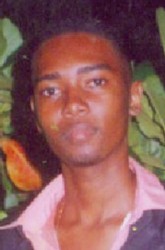Phone records can crack many crime cases but their uneven use by the police has left relatives like those of Delon Melville of Mocha, whose murder was reported to his family by an unknown caller, baffled as to why more isn’t being done with these leads.
Investigators of the Guyana Police Force have used phone leads on several occasions and there is at least one known case where it has proven to be very successful. However, there are relatives of persons murdered who strongly believe that the police’s foot-dragging or lack of an aggressive pursuit of looking into phone records has denied them justice and closure.
Contacted recently, Crime Chief Seelall Persaud told Stabroek News that once investigators feel the need for access to telephone records, a request is made to the service provider—either GT&T or Digicel. He said that once the police are in possession of the records, the information received is then analysed.

He explained that it is the Police Commissioner who would make the request by way of a letter.
Police at one point had encountered difficulties even though the Telecommuni-cations Act 1990 was amended to give police more powers to access information, such as the identity of the person who owns a particular number that could assist in a criminal investigation. Investigators were getting resistance and this was stalling many investigations. In the case of the murder of New Amsterdam Taxi driver Trevor Kissoon, police had to move to the High Court after Digicel had refused to hand over the phone records which was a vital part of the investigation. Those records were subsequently handed over and the police were able to arrest and charge a suspect. That suspect was recently committed to stand trial in the High Court for the murder.
APNU MP Winston Felix, who is a retired Commis-sioner of Police, told Stabroek News that telephone records can play a very important role in a criminal investigation. “You see, a criminal investigation cannot limit itself to one source. They have to use several credible sources and the telephone is one,” he stressed.
Asked if it should always be checked upon as part of any investigation, Felix said that this is best left up to the investigator because “the circumstances in a particular situation should determine whether it should be checked or whether it should be useful. I am saying that once the indication is there, it should be used.”
Reflecting on what happened while he served in the force, he stated that back then the technology was not really there but the introduction of cellular phones has made it easier.
Recently Stabroek News spoke to several families and they expressed the view that the telephone records are important and it is one of the first things that police should pursue at the beginning of any investigation.

On August 2, the decomposing remains of Melville were found in the Mocha, East Bank Demerara backdam, five days after he went missing. It was a cellular phone call which lured him out of his house relatives say. They said that what is more upsetting is that police are yet to tell them who was the last person to have called the man’s cellular phone. The phone is missing.
Grief-stricken relatives told Stabroek News recently that if police had begun tracking the phone from the time they filed a missing person’s report, at least they would have been able to pinpoint the location of the instrument. Until now, the phone number is still active and when relatives call it is answered but the person on the other end keeps saying that they found the phone in Mocha.
Afraid to have their names published, relatives said that based on what they know, just before 8 pm on July 29 Melville received a call on his cellular phone and after a short conversation he told his nephew that he was going on the road and would be back. He was not heard from or seen again.
Relatives got a ‘please call me’ text the following night and when a call was made to Mellville’s phone the person on the other end said “‘I got bad news fuh you, you brother dead.’ I tell the person if he dead just tell me where his body is”, the relative said, while adding that the male on the other end said that he would call back with the directions to where the body was.
The following day relatives ended up at CID Eve Leary and a call was received from Mellville’s cell phone. Relatives told Stabroek News that the caller, who identified himself as Junior, said that he wanted to know what they were doing at the police station. They said that phone was handed over to the police who spoke to the person on the other end. The rank ended up in a room and locked the door.

Stabroek News was told that when the rank emerged he told the relatives that they traced the phone to Meadowbrook and Her-stelling, East Bank Demerara. Relatives explained that the Herstelling that is being referred to is actually a dam in Mocha.
Investigators even told them that they did tracking up to two days after Melville disappeared. Relatives questioned the relevance of this information.
Relatives said that sometimes when they call the cellphone, it is answered and they strongly believe that that person knows a lot. They said that they have told the police that Melville’s Digicel phone number is still in use.
“What baffling us is that if they find the phone or stole it why they wouldn’t have thrown away the SIM instead of using it…Digicel will have the records to show which numbers called Delon phone and what time and also what numbers he called,” one relative said.
“We have made our frustration known to the police. I ain’t giving up ….is like Guyana deh so backward in technology that every time you try to tell them something they telling you something else,” the relative said.
They said too that police need to check the phone records of a young woman in the community who had called Melville around the time he left the house. Relatives, while noting that the girl was detained but released too quickly, said that the young woman has given too many conflicting stories. They expressed belief that it was she who called Melville out of his house but didn’t tell him that she was not home but at a salon in the area.
He ended up at the young woman’s home which is located towards the back dam area.
“They should have gotten a printout of calls to and from both phones,” the relatives stressed, adding that this could be the “breaking lead” in the case.
Sheema Mangar
Like Melville’s murder, the fatal September 11, 2010 robbery of Demerara Bank employee Sheema Mangar remains unsolved. Mangar died after she jumped on the bonnet of a car in pursuit of a man who had snatched her cell phone.
Her mother Radika Thakoor told Stabroek News recently that based on what she knows the phone was never found. The woman said that she was never told anything about phone records or checking to see whether the her daughter’s’s SIM was still in use.
Asked if she believes that doing this should form part of the investigation, the woman responded in the affirmative. She said that this should be the first thing that the police should do.
Observers had noted that since no one knows what really sparked this reaction from Mangar and since the police were getting very few leads in the case, the police could have checked the phone records just to see if they found anything unusual.
When asked about this case, the crime chief, while not specifically saying if an application for telephone records was made, said that this was the larceny of a cell phone. He said that this was based on the reports of eye witnesses who said that someone snatched Mangar’s cellular phone before boarding a car.
Jennifer Persaud
From all indications police have ignored reports from relatives of Jennifer Persaud that they received a telephone call in which fingers were pointed at the uncle of the woman’s reputed husband. Both men had been detained after Persaud and her two small sons were found brutally murdered in their Anna Catherina, West Coast Demerara home on September 22 last year.
Earlier this month, the woman’s mother, Sankhoari recalled that the day after the bodies were discovered, the telephone at Persaud’s home rang. The woman said that when she answered a woman on the other end identified herself as the prime suspect’s mother (who lives, in the United States) and began offering her condolences. She is also the sister-in-law of the other person detained. The woman said that while they were speaking, the phone was snatched from the woman and a male came on the line who said, “It’s not meh son who kill. I know is who, is meh brother,” The phone went dead after that, said Sankhoari.
Relatives, while noting that they went to the police twice in relation to the call, said that this should be one of the key pieces of evidence in the case and as such it needs to be looked into.
Police had applied telephone records to assist them with their investigations into the May 10 murder of cambio dealer Totaram Mohotoo and his wife Bhagwattie. It is unclear if these records were ever received.
It was based on phone records in the Babita Sarjou disappearance case that police were able to arrest a suspect. Phone records showed some suspicious activity between a city resident and a man closely acquainted with Sarjou. The phone records show that the man lied about the communication between himself and the city resident on the night Sarjou disappeared.
The man was subsequently released. Sarjou went missing on November 4, 2010.
The same was also done as part of the investigation into the murder of Seeraj Persaud who was found dead in the Parika Health Centre in February 2010. His brother Boyo Persaud told Stabroek News recently that police did do some work in this regard but nothing much came out of it. He said that when he last called his brother’s number, he got a message that the phone was off.









